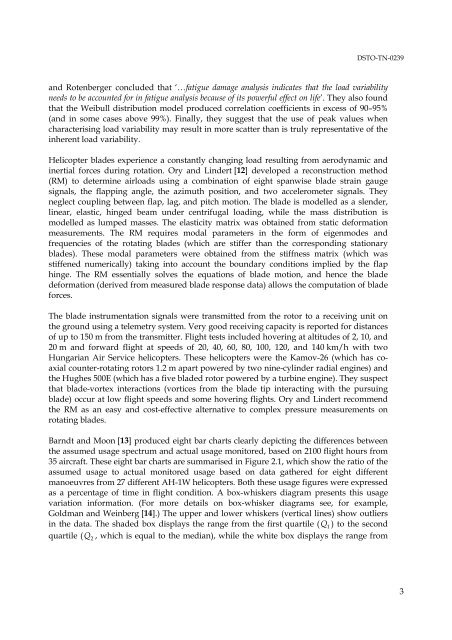Estimation of Structural Component Loads in Helicopters: A Review ...
Estimation of Structural Component Loads in Helicopters: A Review ...
Estimation of Structural Component Loads in Helicopters: A Review ...
Create successful ePaper yourself
Turn your PDF publications into a flip-book with our unique Google optimized e-Paper software.
DSTO-TN-0239and Rotenberger concluded that ‘…fatigue damage analysis <strong>in</strong>dicates that the load variabilityneeds to be accounted for <strong>in</strong> fatigue analysis because <strong>of</strong> its powerful effect on life’. They also foundthat the Weibull distribution model produced correlation coefficients <strong>in</strong> excess <strong>of</strong> 90–95%(and <strong>in</strong> some cases above 99%). F<strong>in</strong>ally, they suggest that the use <strong>of</strong> peak values whencharacteris<strong>in</strong>g load variability may result <strong>in</strong> more scatter than is truly representative <strong>of</strong> the<strong>in</strong>herent load variability.Helicopter blades experience a constantly chang<strong>in</strong>g load result<strong>in</strong>g from aerodynamic and<strong>in</strong>ertial forces dur<strong>in</strong>g rotation. Ory and L<strong>in</strong>dert [12] developed a reconstruction method(RM) to determ<strong>in</strong>e airloads us<strong>in</strong>g a comb<strong>in</strong>ation <strong>of</strong> eight spanwise blade stra<strong>in</strong> gaugesignals, the flapp<strong>in</strong>g angle, the azimuth position, and two accelerometer signals. Theyneglect coupl<strong>in</strong>g between flap, lag, and pitch motion. The blade is modelled as a slender,l<strong>in</strong>ear, elastic, h<strong>in</strong>ged beam under centrifugal load<strong>in</strong>g, while the mass distribution ismodelled as lumped masses. The elasticity matrix was obta<strong>in</strong>ed from static deformationmeasurements. The RM requires modal parameters <strong>in</strong> the form <strong>of</strong> eigenmodes andfrequencies <strong>of</strong> the rotat<strong>in</strong>g blades (which are stiffer than the correspond<strong>in</strong>g stationaryblades). These modal parameters were obta<strong>in</strong>ed from the stiffness matrix (which wasstiffened numerically) tak<strong>in</strong>g <strong>in</strong>to account the boundary conditions implied by the flaph<strong>in</strong>ge. The RM essentially solves the equations <strong>of</strong> blade motion, and hence the bladedeformation (derived from measured blade response data) allows the computation <strong>of</strong> bladeforces.The blade <strong>in</strong>strumentation signals were transmitted from the rotor to a receiv<strong>in</strong>g unit onthe ground us<strong>in</strong>g a telemetry system. Very good receiv<strong>in</strong>g capacity is reported for distances<strong>of</strong> up to 150 m from the transmitter. Flight tests <strong>in</strong>cluded hover<strong>in</strong>g at altitudes <strong>of</strong> 2, 10, and20 m and forward flight at speeds <strong>of</strong> 20, 40, 60, 80, 100, 120, and 140 km/h with twoHungarian Air Service helicopters. These helicopters were the Kamov-26 (which has coaxialcounter-rotat<strong>in</strong>g rotors 1.2 m apart powered by two n<strong>in</strong>e-cyl<strong>in</strong>der radial eng<strong>in</strong>es) andthe Hughes 500E (which has a five bladed rotor powered by a turb<strong>in</strong>e eng<strong>in</strong>e). They suspectthat blade-vortex <strong>in</strong>teractions (vortices from the blade tip <strong>in</strong>teract<strong>in</strong>g with the pursu<strong>in</strong>gblade) occur at low flight speeds and some hover<strong>in</strong>g flights. Ory and L<strong>in</strong>dert recommendthe RM as an easy and cost-effective alternative to complex pressure measurements onrotat<strong>in</strong>g blades.Barndt and Moon [13] produced eight bar charts clearly depict<strong>in</strong>g the differences betweenthe assumed usage spectrum and actual usage monitored, based on 2100 flight hours from35 aircraft. These eight bar charts are summarised <strong>in</strong> Figure 2.1, which show the ratio <strong>of</strong> theassumed usage to actual monitored usage based on data gathered for eight differentmanoeuvres from 27 different AH-1W helicopters. Both these usage figures were expressedas a percentage <strong>of</strong> time <strong>in</strong> flight condition. A box-whiskers diagram presents this usagevariation <strong>in</strong>formation. (For more details on box-whisker diagrams see, for example,Goldman and We<strong>in</strong>berg [14].) The upper and lower whiskers (vertical l<strong>in</strong>es) show outliers<strong>in</strong> the data. The shaded box displays the range from the first quartile ( Q 1 ) to the secondquartile ( Q 2 , which is equal to the median), while the white box displays the range from3
















